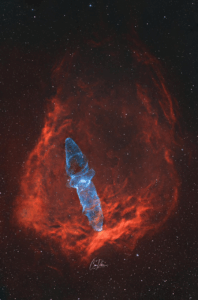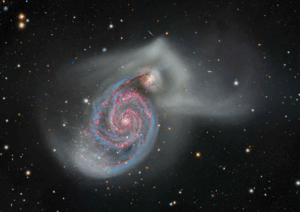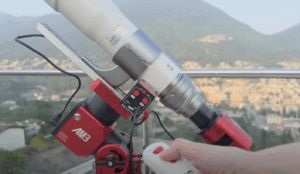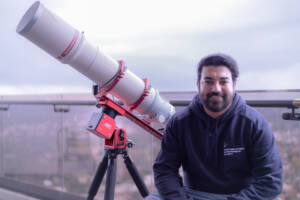
Discovery of the M31 [OIII] emission arc
Recently, a major discovery by an international team of amateur astronomers and scientists has become a huge online hit, and this new discovery is just located in one of the

Hello Chad, thanks for accepting our interview invitation. Congratulations on winning the ASIWEEK competition in week ##48/2023!
Hello, my name is Chad Leader. I live in the Washington, DC area. I’m 46 years old and enjoy astronomy, music, nature and traveling. I’ve been doing astrophotography for a little over four years now.


I’m amazed at how much astro technology has changed since I began the hobby in 2019. There are so many gadgets that make astrophotography more accessible and efficient – for example the ASIAIR. There are also numerous software tools that streamline processing data, including new AI tools that simplify workflow and produce excellent results. It’s a great time to be an astrophotographer.

IC1848 (The Soul Nebula) is a popular emission nebula located in Cassiopeia. I recently purchased an Askar 80PHQ quadruplet astrograph. Paired with an ASI2600MM Pro APS-C camera, this target fits perfectly into the FOV. For this image, I set up my imaging train without a reducer. This produces the best, flattest field at f/7.5 (600mm focal length). I captured SHO narrowband data using 3.5nm filters over several nights totaling 15.5 hours of integration. To better enhance the details and get sharper stars, I drizzled the data to double the image resolution. Overall, I’m really impressed with the telescope/camera combination. The data was very clean and easy to process.

I have three telescopes that I use: an Askar 80PHQ, an iOptron RC8, and a Celestron Edge HD 8. My mounts are a ZWO AM5 and a Sky-Watcher EQ6-R Pro. I use ZWO’s ASI 2600MM Pro, ASI 2600 MC Pro, and ASI 294MM Pro. Everything is operated by an ASIAIR Plus/Pro.

Switching to mono was the best decision I’ve made as an astrophotographer! Especially living in a heavily light-polluted area, mono imaging has made things much easier. In addition to being able to image in true SHO, I’ve found that mono cameras are better for broadband (LRGB) targets from heavy light pollution. Not only are they more efficient at sensing photons, it’s also easier to remove gradients from separate data sets. Obviously, nothing beats a dark sky. But if you are limited in your access to dark sites (as I am), using a mono camera can help produce nice broadband images from light-polluted back yards.




It really depends on the target and telescope I’m using. For example, if I’m imaging a medium-bright target in SHO at f/7, I’ll usually aim for 4+ hours on each data set. If the OIII signal is weak, I’ll double it for that filter. For broadband, it’s highly dependent on the target, sky quality, and how deep I want to go. For example, M42 is very bright. From a dark sky, I can get a really good image with about an hour of integration.
The most challenging part of data acquisition is getting ROUND stars across the FOV. Achieving that involves a lot of equipment being fine tuned and working properly: collimation, reducer back-spacing, guiding (including seeing conditions), PA, mount balance, etc. While it’s challenging, it’s also very satisfying when your image comes out with an excellent field of stars.
My favorite object and image is a close up of the Heart Nebula region (IC 1805 and Melotte 15). This region includes some incredible structures, and SHO colors really provide excellent contrast.

About two years ago, I was imaging in a remote part of Joshua Tree National Park. As my sequence ran, I fell asleep in my chair. I was woken by the sound of something walking through the brush. I shined my light into the area of the sound, and saw two red eyes glaring back at me. I didn’t stick around to find out what it was – but likely a coyote. Be careful out there in the field, folks!

It is tough to find balance for a time-intensive hobby like astrophotography. I have a 4-year old son, so he is my priority. Thankfully, he goes to bed before the stars come out! But, I do try to include him in the hobby. He helps me set up my telescopes, and sometimes will watch me edit an image. He often tries to draw my images as well.
Something I’ve been doing to make my astrophotography more efficient is leaving my set up outside under a telescope cover. This allows me to simply uncover it and get right to imaging on clear nights. All of the automation of the ASIAIR Plus really helps as well. It’s nice to be able to set a “Plan” sequence and let it run all night while sleeping.
I recently completed a Master of Science degree in Space Studies with an Astronomy concentration. My thesis was about utilizing coded music to countermeasure psychological challenges during long-duration spaceflight (for example, a mission to Mars).
Besides that, I enjoy reading up on astrophysics and cosmology. I’m also hoping to get more involved with star parties and outreach at my local astronomy club (NOVAC).

It’s hard to say, but my best moments are when I’m under the stars at a dark site. There’s something very therapeutic about it. I have also had some very cool moments where my photography was featured: short-listed for the Astronomy Photographer of the Year competition, photos published in several magazines, an APOD, winning Astrobin’s IOTD, and (of course) winning ZWO’s image of the week!

I very recently bought an entry-level DSLR to attempt some Milky Way photography. But, my heart is really in deep space photography. The fusion of art, science, and technology make this a perfect hobby for me.
My website: https://www.ancientphotonsastro.com/
My YouTube channel:

Recently, a major discovery by an international team of amateur astronomers and scientists has become a huge online hit, and this new discovery is just located in one of the

To most people, this might just look like a pretty picture. But to astrophotographer Cem Diken, it’s the result of three years of chasing a nearly invisible ghost in the

I was born in Guadalajara, I’m 38 years old, a musician, communications and electronics engineer, and president of the Guadalajara Astronomical Society A.C. since 2020. First Contact with Astronomy Since

This stunning collaborative project comes from astrophotographers Alex Linde and Thomas Hansson, who joined forces across borders to photograph the Whirlpool Galaxy from Sweden, Poland, and Texas, USA. Thomas traveled across


“Two thoughts immediately crossed my mind—the vastness of the cosmos, and that I could also create images like the ones that inspired me.” ” If you spend more time debugging than